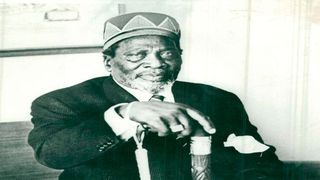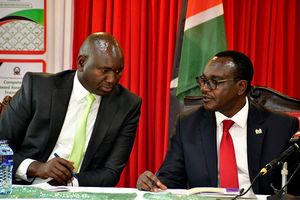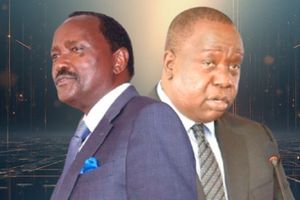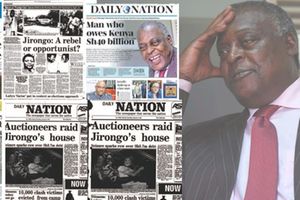
Kenya's founding president, Mzee Jomo Kenyatta.
| File | Nation Media GroupNews
Premium
Jomo military coup fears and the untold secrets of the original Gema
What you need to know:
- Gema, though masquerading as a welfare association, had all the mannerisms of a political party.
- While Gema was not the only tribal organisation in town, it was arguably the most powerful.
Gema, according to its long-time chairman Njenga Karume, had been founded with the blessings of Jomo. There could be some truth there. Some historians, with the hindsight of knowledge, argue that it had been founded to solidify Kenyatta’s presidency and give him a reliable base at a time that the country was going through serious political tensions. Stories of culture were just hogwash tales.
Let me provide a context that is usually ignored.
The July 5, 1969 assassination of Tom Mboya - which was blamed on Kenyatta succession politics — and the crackdown on members of Jaramogi Oginga Odinga’s Kenya People’s Union (KPU), after the president was stoned in Kisumu on October 25, 1969, had made the Kenyatta presidency unpopular — especially at a time when he was going through health challenges.
Next door in Uganda, and 44 days before Gema was registered on March 10, 1971, President Milton Obote had been toppled by Idi Amin, sparking fear of copycat coups in the region.
British historian Charles Hornsby, in his book, Kenya: A History Since Independence, captures the political tensions that had gripped the country following Amin’s coup next door. He writes: “The likelihood of a military coup in Kenya had been growing since 1969, with senior army officers, including army commander Brigadier Joseph Ndolo, musing on the country’s future.”
He goes on: “The likelihood of military action increased after Amin’s intervention (in Uganda). By March 1971, Ndolo’s opinions had come to the attention of the British, who discussed the mechanics of a possible attempt in detail.”
Dr Hornsby quotes a March 1971 British High Commission report, now at the British Kew Archives and which is titled: ‘An Army Coup in Kenya’ and ‘Succession to the Presidency in Kenya, 1971’. The archival document says that ‘In February and March, Major General Ndolo discussed the situation in Kenya with a number of people in terms which clearly indicated that he thought that he would have to mount an army coup on Kenyatta’s death if not before.’
Gema’s hasty registration
According to Hornsby, “The British took Ndolo seriously, believing that there was ‘a real possibility of an attempt of an army coup within the next 18 months or so’. They concluded that it would not significantly harm British interests, but that Britain would be better served by the survival of the existing regime. They, therefore, continued to provide discreet advice to make a coup less likely, while further tightening links with the army.”
The timing of Gema’s emergence during this period and the hasty registration — hours after it gave its papers to Charles Njonjo — could only point to efforts to save the Kenyatta presidency and retain the backing of the Gikuyu, Embu and Meru communities.
More so, we see Kenyatta’s relations with the military improve and he talked glowingly about them.
Interestingly, although they are linguistically closer to the three communities, the Kamba had been left out of Gema — after all ,they were implicated in the coup-talk against Kenyatta. Questions have always been raised why Kenyatta did not prosecute Major General Ndolo, if indeed he was involved.
That answer is found in a telex message sent on June 23, 1971 by Sir Eric Norris, the British high commissioner, in which he quotes then Vice President Daniel arap Moi saying that Jomo had decided not to prosecute Ndolo.
In his telex message to the Foreign and Commonwealth Office, Sir Eric Norris wrote: “Vice President (Daniel arap Moi) told me this morning that the President has said that he will not allow General Ndolo to be prosecuted. He considers that he has been misguided and stupid but not vicious and his 37 years of loyal service should be taken into account. If he is allowed to retire, he will henceforth be loyal and this is important since he is an important figure in the Kamba tribe. In any case, Mr Moi said, Ndolo was not clever enough to have worked out a plot. The ministers were convinced that the Chief Justice (Kitili) Mwendwa had been advising him.”
It was within this political context that on March 10, 1971 — and within hours after tabling its documents — Attorney General, Charles Njonjo, had registered the hitherto unheard of Gikuyu Embu and Meru Association — whose acronym was Gema.
Tribal groupings
Again, the intelligence had got wind of a coup that was to be staged on April 8, 1971 for which the fall guy became Yatta MP Gideon Mutiso. Perhaps to appease the Luo, the government had on March 27, 1971 released Oginga Odinga from detention — which was two weeks after the registration of Gema.
Whether this was a coincidence is not known. But in Parliament, Mr Njonjo was asked to table the names of the office bearers and the aims and objectives of the organisation. While Mr Njonjo answered only one part of Permanus Munyasia’s question, he invoked a clause in the Standing Order that a member could refuse to answer a question if the answer had been supplied in advance. Pressed, Mr Njonjo lost his cool: “Nonsense … do not talk nonsense!”
Interestingly, Speaker Fred Mati sided with Mr Njonjo, saying he had been provoked.
It is ironic that Mr Njonjo, whose disdain for such tribal groupings was epic, agreed to let it operate, although Karume claims that he was ordered by Kenyatta to register it.
Gema, though masquerading as a welfare association, had all the mannerisms of a political party and Jomo, as Njenga Karume would later reveal, only allowed its formation to “retain support of his lieutenants”.
Later, and Karume says as much in his autobiography, Beyond Expectations, Jomo “became quite uncomfortable with the influence of the organisation and even rebuked its leaders.”
After Gema’s first meeting at the Wambugu Farm in 1971, the non-political barons of Mt Kenya argued that they had been side-lined by the politicians and demanded more say within the community. They sought to see Kenyatta but on the date they had been given, Kenyatta also invited the Mt Kenya MPs. It was classic Jomo.
Wealthy politicos
“What we thought would be a closed-door meeting with just the three of us and Kenyatta turned out to be a meeting of more than 50 people. Ninety per cent of Gema MPs were present,” recalled Karume.
His delegation consisting of Matu Wamae, the Industrial Commercial Development Corporation chairman, and Central Bank governor Duncan Ndegwa was outfoxed. Finally, according to Karume, Kenyatta asked the two warring factions — the politicians and the businessmen — to work together.
While Gema was not the only tribal organisation in town, it was arguably the most powerful and its later line-up looked like a roll-call of the wealthy politicos and businessmen of Mt Kenya region. Thus, it was not in the same league as Paul Mboya’s Luo East Africa Union, the Mulu Mutisya-led New Akamba Union or the Abaluhya Union.
When it was founded, it had Dr Julius Gikonyo Kiano as its first interim chairman, Mwai Kibaki as treasurer, Jeremiah Nyaga as vice chairman and Kirinyaga MP Lucas Ngureti as secretary general. Others were Nyeri MP Waruru Kanja (organising secretary) and Jackson Angaine as assistant Secretary general.
But by 1973, when the first elections were due, Kenyatta asked Karume to take over the chairmanship. An endorsement by Gema for political seats was always a tacit approval. In the 1974 elections in Bahati, the seat vacated by Mwai Kibaki after he left for Othaya, an aspirant, Muthoni Likimani complained to the supervisor of election, N J Montgomery, that Gema had interfered with the process and had backed Dr James Muriuki.
It was also allowed to form Gema Holdings Ltd, which would be the economic arm of the group. While the group bought various properties and farms, how they were later dished or squandered is a story for another day. But, some people made a lot of money.
But did Gema have a political agenda? In his autobiography, Mr Karume, who for a long time was the Gema chairman, dismissed the notion that Gema was started with a political agenda. He argued that the idea behind the tribal associations was to “give people a greater sense of belonging and identity … I know not everyone agrees with this assessment.”
Gema's role in Moi presidency
That, of course, may not be the entire truth. It was Gema’s decision that Kibaki should vie for a Nyeri seat since the Nyeri people were pestering Kenyatta with a Cabinet position. At one point, Kenyatta is said to have asked Kibaki, “Kai Kibaki woriire Nairobi? (Kibaki, you got stuck in Nairobi?)
It was after vocal legislator J M Kariuki was assassinated in 1975 that the political element of Gema was seen. After Parliament formed a select committee to investigate the murder, Gema released a statement saying: “We find it fit to ask our members and the public not to be misled by prophets and leaders of doom who go to bars and preach malicious and damaging views about our country and its leaders.”
Later, after the Elijah Mwangale Select Committee delivered its report, Gema called a press conference and asked Kenyatta to initiate his own investigations to probe the activities of the MPs who were in that committee “because they are not themselves angels and some of them may be involved in the murder,” according to Gema Secretary General Ireri Ndwiga.
Also, in 1976, some Gema leaders, led by Ngwataniro Mutukanio Land Buying Company chairman, Kihika Kimani, started a campaign against Moi and they joined the Change the Constitution group, which was to bar the vice-president from taking over for 90 days – in case Kenyatta died. It is now known from records — including US intelligence reports — that Oginga Odinga was perceived as the main beneficiary of this plot as the senior most politician after Jomo.
But Gema’s efforts in politics were thwarted by Mr Njonjo and Mr Kibaki, who had a bone to pick with the group. With a divided house, Gema — as a group — played little role in the Moi presidency. Again, Moi had the blessings of the British government. It is interesting that in 1979, and after Moi got the presidency, his first task was to ban Gema.
Njonjo had told parliament that Gema was a criminal organisation and had all the officials of Agricultural Holdings (the name Gema had adopted) arrested for “failing to file returns”. From then on, attempts to revive Gema, as a group, have always been looked at suspiciously. But while the cultural group died, attempts to have Mt Kenya as one voting block has only happened twice under Kibaki and twice for Uhuru.
It appears that what was crafted out of Kenyatta I succession politics, and was caught in the same web in 1978, is now in limbo as Uhuru Kenyatta gets into the last stretch of his presidency. It will be interesting to see how the divisions between Mt Kenya East and Mt Kenya West will solidify and who will gain from them.
[email protected] @johnkamau1





